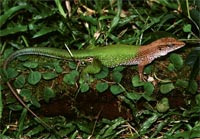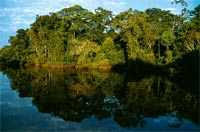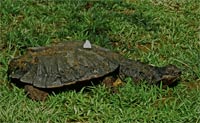Checking out the wild herps along the Amazon River.
The river flows for some 4,000 miles in an easterly direction with its origin high up in the Andes Mountains. When it finally reaches the Atlantic Ocean, it is said to be nearly 200 miles wide. Along its course a multitude of colorful birds soar the skies, while in the dense jungle, giant anacondas and black caimans prove formidable adversaries. Schools of flesh-eating piranhas, neon tetras and majestic angelfish frequent the water habitats, and innumerable insect species defy description. Botanically it is a paradise like no other. In total, this plethora of natural wonders is best called Amazonia.

All photos by Karl-Heinz Switak
Barred monkey frog (Phyllomedusa tomopterna).
Ever since I ordered my first green anaconda from a dealer in Florida during the late 1950s, I had envisioned meeting Eunectes murinus murinus on its home ground deep in the mosquito-infested jungles of South America. The aforementioned individual, a 7-foot specimen with an attitude problem like no other, emerged from its shipping container and immediately inflicted a painful wound upon my right knee. It took two weeks for one of the broken-off teeth to fester out. Since that time I have roamed parts of the South American continent on several occasions, but it wasn’t until late June of 2003 that my initial dream became reality.

The caiman lizard (Dracaena guianensis) is a good swimmer and may reach a total length of 3 feet.
Welcome to the Jungle
We spent our first night in Iquitos, Peru, where we savored local cuisine and slowly acclimated to a hot and humid climate. It also allowed time to make certain all camera gear functioned correctly, take our anti-malaria medication and naturally get acquainted with fellow travelers. The following morning, during a torrential downpour, we boarded our able-bodied vessel, the Tucunare, and headed east on the mighty Amazon.

Approximately 14 inches long, a young northwest black-backed coral snake (Leptomicrurus narduccli melanotus) was on the move during daylight hours. The snake seldom exceeds 24 inches in length.
Now Dick Bartlett informed me that numerous species of amphibians and reptiles were already awaiting my every pleasure at the Madre Selva Biological Station, our base of operation for nearly a week. “I know this will interest you especially,” he said. “We have a small green anaconda for you.”
That statement alone sent my adrenaline racing, and the cold beer that followed wasn’t bad either. Finally, after so many decades, I would see a genuine green anaconda in situ.
As we navigated the powerful and often mysterious Amazon, I knew schools of flesh-eating piranha were likely swimming nearby, and someone spotted a large sloth high up in a tree. Then, just before sunset a few Amazon River dolphins (Inia sp.) crested the surface of the water, reflecting a pink body coloration that glistened like a giant diamond against the brownish waters.

A number of the deadly fer-de-lance (Bothrops atrox), including this young specimen, were found around Madre Selva Biological Station. Often quick to strike, they may reach 6 feet in length.
Anxious for Anacondas
We arrived at Madre Selva very late at night. After unloading equipment and changing into suitable attire (dinner had been served aboard ship), the entire group took a stroll along a rain-soaked trail winding its way through the nearby jungle. At least three species of amphibians were calling, and to our delight, only a few obnoxious mosquitoes made an appearance. We all carried flashlights, without which you couldn’t see the front of your nose — it was pitch dark! Dick cautioned everyone to be on the lookout for coral snakes. Although seldom observed, they were said to be common in this neck of the woods. Unfortunately, our walk wasn’t productive.

The author's boyhood dream came true when he gazed upon this young green anaconda in situ. Scientifically known as Eunectes murinus murinus, it is one of the largest serpents in the world.
We had more luck during subsequent travel along these trails. We came across a small western ribbon coral snake (Micrurus lemniscatus helleri) and an even smaller northwest black-backed coral snake (Leptomicrurus narduccii melanotus). Both were moving over damp substrate in daylight, and neither attempted to bite. At the station they had a small aquatic coral snake (Micrurus surinamensis surinamensis) previously collected right next to the Amazon River.
Speaking for myself, the most important serpent to appreciate and photograph was that green anaconda. Collected locally, it measured less than 3 feet in length, wore a scaly coat of total perfection and never missed the opportunity to bite the hand holding it. Green anacondas are known for having an attitude problem, and this individual was no exception. Upon our departure from Madre Selva, we released it along the shores of the Rio Orosa, and it quickly disappeared among tangled vegetation.
Additional serpents we observed, most brought in by local Indians, included the following varieties: several species of water snakes (Helicops spp.), an almost 5-foot-long rusty whipsnake (Chironius scurrulus), a young mussurana (Clelia clelia), adult and young snail-eating snakes (Dipsas catesbyi and D. indica), a green-striped vine snake (Oxybelis argenteus), a common false viper (Xenodon rhabdocephalus), a red vine snake (Tripanurgos compressus), speckled forest pit vipers (Bothriopsis taeniata) and several of the deadly fer-de-lance (Bothrops atrox). The latter proved to be quite common in this region. As a matter of fact, we found a young specimen on a piece of wood almost next to the steps that led into our dining area. All buildings were elevated, leaving ample dry space below for snakes and other creatures to use during torrential downpours.

Local inhabitants brought this adult Amazon tree boa (Corallus hortulanus) just before the author was to leave Madre Selva
Exciting Finds
Lizards were also plentiful around Madre Selva, but they quickly disappeared when approached too closely. One of the fastest and most colorful was the Amazon whiptail (Ameiva ameiva). At night geckos made an appearance, and during the day with a bit of luck, you might find a tegu lizard (Tupinambis sp.) running through the compound.

Adult Amazon whiptail lizards (Ameiva ameiva) are generally common and move like greased lightining. They can grow to more than 14 inches in total length.
By far the most spectacular species brought to us was an adult caiman lizard (Dracaena guianensis). After a lengthy photo session we released it at the water’s edge. Being largely aquatic, it dove in without a second’s hesitation. Effectively using its vertically compressed tail as both a propellant and a rudder, it first swam for a short distance, then suddenly dove below the surface and disappeared from sight.

Adult female smoky jungle frogs (Leptodactylus pentadactylus) reach a snout-to-vent length of about 7 inches.
Many chelonian species, ranging from the stately, land-loving tortoises to strictly aquatic turtles, abound in the Amazon. Only one tortoise was collected locally, and it was a very young yellow-footed tortoise (Geochelone denticulate). Adults reach a size of about 15 inches, though gigantism has been recorded elsewhere in the Amazon where females measure more than 30 inches.
Only two turtles were brought in by local Indians. One was a young Amazon river turtle (Podocnemis sextuberculata), and the other was a matamata (Chelus fimbriatus) of monstrous size! The native who delivered this prize in his dugout canoe had his hands full carrying such a lively load. We were all ecstatic and thankful for having seen such a magnificent beast.

This smooth-fronted caiman (Paleosuchus trigonatus) was collected near the Apayacu River. Adults reach a length of approximately 6 feet. When handled, they are ill-tempered and quick to bite.
Of all the crocodilian species found in the Amazon region, the only one we had a chance to observe was a young smooth-fronted caiman (Paleosuchus trigonatus) brought to us from several miles away. It appeared in perfect health, lunging out at any moving object within close proximity. Its needle-sharp teeth are capable of inflicting a painful bite. Luckily we all came away unscathed.
Poetry in Motion
It goes without saying that a great diversity of amphibian species call the jungle their home. The most common variety at Madre Selva was the gaudy-colored, three-striped poison frog (Epipedobates trivittatus). I always found at least two or three on my way to the dining area. At the water’s edge we occasionally located small individuals of the Surinam toad (Pipa sp.). However, to describe each and every species we encountered, and those local Indians brought to us, would require a separate account all by itself.

This shoreline of the Rio Orosa was near the author's camp.
Those that most impressed me were the “giants”: the gladiator treefrog (Hyla boans) and the smoky jungle frog (Leptodactylus pentadactylus). Those exhibiting superb coloration and bold patterns included the variable clown treefrog (Hyla triangulum) and the common spotted treefrog (Hyla punctata). My absolute favorite was the barred monkey frog (Phyllomedusa tomopterna). Its slow and deliberate gait is best described as amphibian “poetry in motion.”
Swimmer Beware
Although this jungle safari catered primarily to people with a keen interest in herpetology, several of us were equally enthralled by the millions of fish species that abound in a variety of aquatic habitats. My nephew Ian caught numerous piranhas while fishing off the boat, and the largest were prepared for a tasty meal. Other fish varieties collected included leaf fish, wolf fish, neon tetras, hatched fish, Apistogramma cichlids, and Hoplosternum catfish — just to mention a few.

Local Indians brought this enormous matamata turtle (Chelus fimbriatus) to the author's camp along the Rio Orosa. It was later released back into the river.
Ian and my friend’s son Gerald also swam in water frequented by piranhas. Both returned onto land with all appendages firmly attached. Our greatest concern while swimming was a tiny and slender fish called candiru. It has the disgusting habit of swimming up the urinary tract of mammals, including humans, and can only be removed through painful surgery. Therefore, any swimsuit worn had to be extremely tight-fitting.
In the afternoon of our departure from Madre Selva, we were almost ready to step aboard the Tucunare when local inhabitants brought us several prize specimens. Shouts of joy echoed through the jungle as people maneuvered for a closer look, while others scrambled for the best position to photographically record these beauties. One was a subadult aquatic coral snake, and the other was a full-grown Amazon tree boa (Corallus hortulanus). Oh yes, I mustn’t forget the plastic bag full of 4- to 5-inch, boldly patterned caterpillars of the genus Pseudosphinx.

This young ornate snail-eating snake (Dipsas catesbyi) was found near camp. Adults reach a length of about 28 inches
The coral snake exhibited subdued coloration with a hint of blue in its eyes (the process before shedding) and behaved in typical neurotic fashion by thrashing its body back and forth at even the slightest of movements. Obtaining a worthwhile shot of this individual took a lot of patience. The tree boa proved a more cooperative subject during our photographic endeavors, but knowing it boasted a mouth full of sharp teeth, we never pushed providence. To our delight, it never made the slightest attempt to bite.
Parting Shots
Shortly after departing Madre Selva, first traveling a short distance on the Rio Orosa, we slowly and laboriously made our way up the Amazon against a most powerful current. Along the way, with daylight waning, we observed a few large green iguanas (Iguana iguana) at the water’s edge, but all were high up in trees and very difficult to photograph. Sometime near midnight we dropped anchor in a favorable location along the Amazon’s shore, and all of us looked forward to a well-deserved rest, especially the crew. They worked diligently in maneuvering our vessel through a mass of floating logs, islands of vegetation and other dangerous debris.

Three-striped poison frogs (Epipedobates trivittatus) were quite common around the author's camp.
Shortly after daybreak, mist and cloud cover engulfed the entire region, and I climbed on deck and noticed a very large green iguana on an almost leafless tree some 30 feet off the ground. This one I managed to photograph, but again, it wasn’t really a worthwhile image.
After returning to Iquitos for our last night in Amazonia, our entire contingent of nature lovers was treated to a superb meal at Restaurant El Meson, operated by the capable expertise of Señor Juanito (“Little John”). The meal consisted entirely of authentic Peruvian delicacies, including the giant freshwater fish arapaima (or paiche), a large rodent called paca, barbecued ribs of wild peccary, spectacled caiman, yellow-footed tortoise, heart of palm, yucca and a powerful alcoholic concoction known as pisco sour. Later in our hotel, the El Dorado, we were lulled to sleep by people singing the U.S. national anthem. It was the Fourth of July.
Thanks to Margarita Tours of Florida, to Dick and Patricia Bartlett and to a most knowledgeable Dr. Devon Graham for providing the opportunity, the enthusiasm and the many hours of endearing friendship.



